


THE TREATY OF MANGALORE 1784 (G3b)
END OF THE SECOND ANGLO-
xxxxxAs we have seen, the second
of the Anglo-
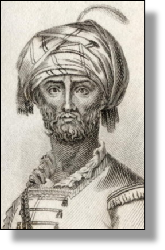 xxxxxAs we have seen, the dispute between the
British and the State of Mysore in southern India began as far back
as 1769, and was centred around an attempt by the Mysore leader,
Hyder Ali (illustrated), to seize the British trading post (or
factory) at Madras. The second of the Anglo-
xxxxxAs we have seen, the dispute between the
British and the State of Mysore in southern India began as far back
as 1769, and was centred around an attempt by the Mysore leader,
Hyder Ali (illustrated), to seize the British trading post (or
factory) at Madras. The second of the Anglo-
xxxxxThat the
British finally won the conflict was due in large part to the
military direction and the skilful diplomacy of the then governor-
xxxxxFive years
later, however, Tippu Sahib was again at war with the British,
this time for allegedly attacking their ally, the Raja of
Travancore. Tippu was eventually forced to submit in 1792 but, as
we shall see, it was not until 1799 that he was finally defeated and killed during the
capture of his capital Seringapatam. The British then took control
of his state and the Anglo-
Acknowledgements
Hyder Ali: by
the engraver J.W. Cook (active 1827/32) – location unknown. Calcutta: date and artist unknown. Nabobs:
date and artist unknown. Hastings: by
the German painter Johann Zoffany (1733-
Including:
The India
Act of 1784

xxxxxThe India Act was passed in the same year as the Treaty of Mangalore (1784), and this took much of the administrative power away from the East India Company. As we have seen, the Company was formed in 1600 (L1), and gradually gained control over much of the Indian subcontinent, especially after the final defeat of their rivals, the French, at the Battle of Wandewash in 1761. By the end of the 1760s, however, bribery and corruption was rife in the company, and the British government began a series of moves to bring this vast land more under its control. After various measures had met with limited success, the India Act was passed in 1784. This set up a Board of Control which carefully monitored the Company’s activities, could veto its decisions, and had powers to dismiss company officials. By the 1830s the company had lost its commercial role and was merely an agent of the Crown. However, as we shall see, it was not until 1858, after the Indian Mutiny of 1857 (Va), that the company was finally closed down.
 xxxxxIn the same year as the Treaty of Mangalore (1784),
the British government, under the leadership of its new prime
minister, William Pitt the Younger, passed the India
Act. This created a government Board of
Control tasked with overseeing the political, military and
financial affairs of India, hitherto exercised almost entirely by
the British East India Company.
xxxxxIn the same year as the Treaty of Mangalore (1784),
the British government, under the leadership of its new prime
minister, William Pitt the Younger, passed the India
Act. This created a government Board of
Control tasked with overseeing the political, military and
financial affairs of India, hitherto exercised almost entirely by
the British East India Company.
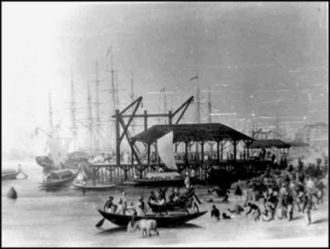 xxxxxAs we have seen, it was in 1600 in the reign of Elizabeth I that the East India
Company was formed. The major trading forts were established at
Madras, Bombay and Calcutta (illustrated), and by the 1650s over 20 of these “factories” (as
they were called) were up and running. For some years in the 18th
century the company’s exclusive trading rights were challenged by
the French, but Robert Clive’s victory over them at Arcot in 1751,
along with their decisive defeat at the Battle at Wandewash in 1761
and the capture of their base at Pondicherry the following year,
gave the company a free hand. Within a few years it controlled vast
areas of the subcontinent, either by direct rule or through a
network of alliances with local princes.
xxxxxAs we have seen, it was in 1600 in the reign of Elizabeth I that the East India
Company was formed. The major trading forts were established at
Madras, Bombay and Calcutta (illustrated), and by the 1650s over 20 of these “factories” (as
they were called) were up and running. For some years in the 18th
century the company’s exclusive trading rights were challenged by
the French, but Robert Clive’s victory over them at Arcot in 1751,
along with their decisive defeat at the Battle at Wandewash in 1761
and the capture of their base at Pondicherry the following year,
gave the company a free hand. Within a few years it controlled vast
areas of the subcontinent, either by direct rule or through a
network of alliances with local princes.
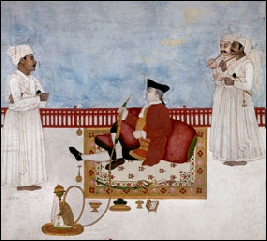 xxxxxTowards the end of the century, however, a series of
moves were taken by the British government to bring this vast new
territory progressively under the authority of the Crown. Quite
apart from the daunting task of administrating such a huge and
diverse population, there was growing concern at home, and
questions were being asked, about the culture of bribery and
corruption within the company itself. In the India of this time,
where a myriad of small principalities were vying with each other
to retain or improve their position, there was ample opportunity
for double-
xxxxxTowards the end of the century, however, a series of
moves were taken by the British government to bring this vast new
territory progressively under the authority of the Crown. Quite
apart from the daunting task of administrating such a huge and
diverse population, there was growing concern at home, and
questions were being asked, about the culture of bribery and
corruption within the company itself. In the India of this time,
where a myriad of small principalities were vying with each other
to retain or improve their position, there was ample opportunity
for double-
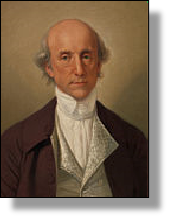 xxxxxIn their periods as governor of Bengal, both Clive in the mid-
xxxxxIn their periods as governor of Bengal, both Clive in the mid-
xxxxxIt
was doubtless for this reason that Pitt’s India Act was passed in
1784, the year before Hastings’ retirement. The Board of Control
it set up was given jurisdiction over the governor-
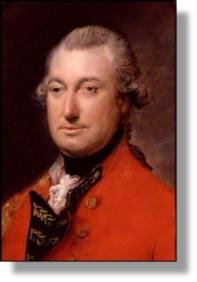
xxxxxIt
fell to the next governor-
 xxxxxIncidentally, at the
government’s first review of the company, held in 1793, an attempt
was made to compel the company to support missionary work in
India. The company rejected the idea, and it was for this reason
that the Society for Missions in Africa and the East was formed in
1799, renamed the Church Missionary
Society in 1812. ……
xxxxxIncidentally, at the
government’s first review of the company, held in 1793, an attempt
was made to compel the company to support missionary work in
India. The company rejected the idea, and it was for this reason
that the Society for Missions in Africa and the East was formed in
1799, renamed the Church Missionary
Society in 1812. ……
xxxxx…… Andxit was in 1793 that the
Englishman William Carey
(1761-
G3b-


